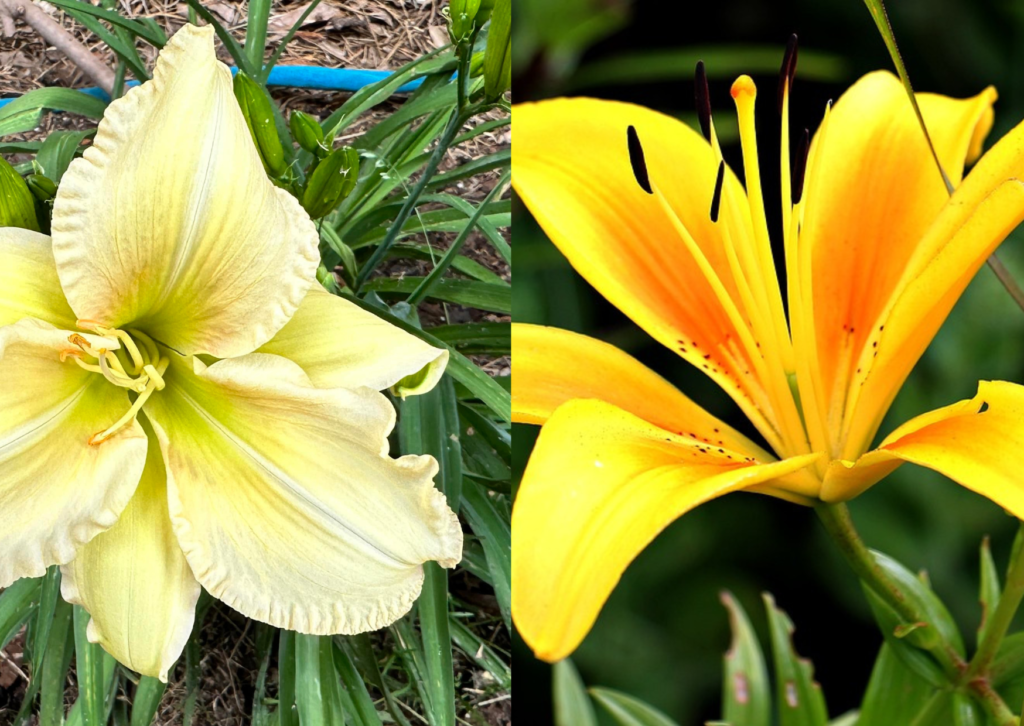When it comes to gardening and landscaping, knowing the difference between lilies and daylilies is essential. While the two plants may share a similar name, they belong to different botanical families and exhibit distinct characteristics. Understanding these differences allows gardeners and enthusiasts to make informed choices about cultivation, care, and aesthetic arrangements. In this comprehensive guide, we will delve into the world of lilies and daylilies, exploring their unique features, identifying traits, and uncovering the nuances that set them apart.
What are Lilies?
Lilies belong to the genus Lilium, which encompasses a diverse group of flowering plants known for their exquisite blooms. These perennial herbs feature erect stems adorned with large, showy flowers. Lilies are renowned for their elegance and fragrance, making them popular choices in gardens and floral arrangements worldwide.
Common types of lilies
The Lily genus encompasses various species, each with its own distinct characteristics. Some common types of lilies include the Oriental Lily, Asiatic Lily, Trumpet Lily, and Easter Lily. These variations exhibit differences in flower shape, size, color, and fragrance, providing a wide range of options for gardeners to choose from.
Morphological features of lilies
Lilies typically have long, slender stems with lance-shaped leaves arranged in whorls or spirals. Atop each stem sits a magnificent flower composed of six petals arranged in a symmetrical pattern. The petals may be trumpet-shaped, recurved, or star-shaped, depending on the specific variety. Lilies also possess bulbous underground structures known as bulbs, which play a crucial role in their propagation and growth.
Natural habitats and cultivation
Lilies are native to various parts of the world, including Asia, Europe, and North America. They thrive in temperate regions and require well-drained soil, ample sunlight, and adequate moisture. While some lilies prefer acidic soil, others can tolerate alkaline conditions. With proper care, lilies can be cultivated in gardens, containers, or even as cut flowers.
What are Daylilies?
Daylilies, scientifically known as Hemerocallis, are herbaceous perennials appreciated for their vibrant and abundant blooms. Unlike lilies, which belong to the Lilium genus, daylilies are classified under their distinct botanical group. Daylilies are named for their individual blooms, which typically last only a day before fading, but they make up for their brevity with a profusion of flower buds.
Common types of daylilies
The Hemerocallis genus boasts a wide array of daylily cultivars, with thousands of registered varieties. Some popular daylily types include the Stella de Oro, Happy Returns, tiger lilies, and Kwanso. These cultivars exhibit different flower colors, shapes, sizes, and bloom times, offering gardeners endless possibilities for creating stunning displays.
Morphological features of daylilies
Daylilies feature long, arching leaves that form clumps of foliage. Each leaf has a characteristic blade shape, which can be linear, lanceolate, or strap-like, depending on the cultivar. The height of daylily foliage varies among different varieties, ranging from compact sizes to towering forms. The flowers of daylilies are trumpet-shaped or funnel-shaped, with three outer sepals and three inner petals.
Natural habitats and cultivation
Daylilies are native to Asia, particularly regions like China, Korea, and Japan. They have adapted to various climatic conditions and can be found in diverse habitats, including meadows, woodlands, and grasslands. Daylilies are known for their adaptability and can be successfully grown in different climates. They prefer fertile, well-drained soil and thrive in areas with abundant sunlight.
Key Differences between Lilies and Daylilies
A. Flower structure and arrangement
One of the primary distinctions between lilies and daylilies lies in their flower structure and arrangement. Lilies typically have large, solitary flowers borne at the top of each stem. These flowers consist of six petals, often with distinct markings and patterns. In contrast, daylilies produce multiple flowers on each scape (flowering stem), with each individual flower lasting only a day. Daylilies also have distinct throat patterns and often exhibit a different range of colors compared to lilies.
B. Bloom duration and frequency
Another notable difference is the bloom duration and frequency. Lilies generally have a shorter blooming period, with each flower lasting for several days to a week. In contrast, daylilies produce a profusion of flowers over an extended period, often blooming for several weeks or even months. This characteristic gives daylilies a prolonged flowering season and ensures a continuous display of colorful blooms in the garden.
C. Growth habit and foliage
Lilies and daylilies differ in their growth habits and foliage characteristics. Lilies typically grow from bulbs, and their stems emerge directly from the ground. The foliage consists of long, lance-shaped leaves arranged in whorls along the stem. Daylilies, on the other hand, grow from clumps or crowns, with their leaves forming arching mounds of foliage. The leaves are usually grass-like or strap-like in shape, creating an attractive backdrop for the flowers.
D. Propagation and cultivation methods
Propagation methods also vary between lilies and daylilies. Lilies are commonly propagated through bulbs, which can be divided and replanted. Alternatively, lilies can be grown from seeds, although this method requires more time and patience. Daylilies, on the other hand, are primarily propagated through division. The clumps can be divided into smaller sections, each containing roots and foliage, and then replanted in suitable locations.
Similarities between Lilies and Daylilies
A. Flower color and variety
Despite their differences, lilies and daylilies share similarities when it comes to flower color and variety. Both plants offer a wide range of color options, including shades of white, yellow, orange, pink, red, and purple. Additionally, both lilies and daylilies have been extensively hybridized, resulting in countless cultivars with unique flower forms, patterns, and combinations of colors.
B. Environmental requirements
Lilies and daylilies have similar environmental requirements for healthy growth. Both plants thrive in well-drained soil, although their specific pH preferences may differ slightly. Adequate sunlight is crucial for both lilies and daylilies, as they require several hours of direct sunlight each day to promote robust growth and vibrant blooms. Regular watering, sufficient spacing, and appropriate fertilizer application are also necessary for optimal performance.
C. Potential for hybridization
Both lilies and daylilies have been extensively bred and hybridized by horticulturists and garden enthusiasts. The hybridization process allows for the creation of new cultivars with desired characteristics such as unique flower forms, increased disease resistance, and extended blooming periods. The potential for hybridization has led to an astonishing variety of lilies and daylilies available in the market today.
VI. How to Identify Lilies and Daylilies
A. Visual cues and distinguishing features
To accurately identify lilies and daylilies, it’s important to observe their visual cues and distinguishing features. Pay attention to flower structure, arrangement, and bloom duration. Look closely at the foliage and growth habit of the plant. By noting these characteristics, you can differentiate between the two species and determine whether you have lilies or daylilies in your garden.
B. Examination of flowers, leaves, and stems
Examine the flowers, leaves, and stems of the plant. Observe the number of petals, the presence or absence of a distinct throat, and the shape of the leaves. Lilies typically have six-petaled flowers, while daylilies have distinct trumpet-shaped or funnel-shaped blooms. Lilies have whorled or spirally arranged leaves along their stems, while daylilies have arching, grass-like or strap-like foliage.
C. Comparison of growth patterns and life cycle
Comparing the growth patterns and life cycles of lilies and daylilies can also aid in identification. Lilies grow from bulbs, with new stems emerging each year from the underground structures. Daylilies, on the other hand, grow from clumps or crowns, producing new shoots and flowers from the existing plant material. Observing these growth patterns can provide valuable clues for identifying lilies and daylilies.
VII. Common Uses and Benefits
A. Ornamental purposes in landscaping & gardens
Both lilies and daylilies serve as popular choices for ornamental purposes in landscaping and gardens. Their striking blooms add beauty and elegance to flower beds, borders, and containers. Lilies are often used in formal gardens and bouquets, while daylilies are favored for their ability to create colorful, low-maintenance displays.
B. Cultural and historical significance
Lilies hold cultural and historical significance in various societies around the world. They have been revered for centuries and are associated with symbolism, myths, and religious ceremonies. Lilies are often used in cultural celebrations, such as weddings and funerals, representing purity, beauty, and rebirth. Daylilies, although less steeped in cultural history, are appreciated for their resilience and adaptability.
C. Symbolism and meanings associated with lilies and daylilies
Lilies and daylilies carry symbolic meanings in different cultures and contexts. Lilies are often associated with purity, innocence, and spirituality. They can also represent love, devotion, and motherhood. Daylilies, with their ephemeral blooms, symbolize the fleeting nature of life and the beauty found in the present moment. They are often linked to resilience, endurance, and embracing life’s transient joys.
Wrapping up
In conclusion, lilies and daylilies are distinct yet captivating plants that bring beauty and charm to gardens. While lilies belong to the Lilium genus and exhibit large, solitary flowers with shorter blooming periods, daylilies, classified as Hemerocallis, produce multiple flowers on each scape and have a more extended blooming season. Despite their differences, both lilies and daylilies offer a wide variety of colors, require similar environmental conditions, and have potential for hybridization.
Understanding the differences between lilies and daylilies is crucial for gardeners, horticulturists, and flower enthusiasts. It allows for informed decision-making regarding cultivation, care, and design choices. By recognizing their unique characteristics, we can appreciate the individual beauty and contributions of both lilies and daylilies to the world of plants.
Whether you are a seasoned gardener or a novice plant enthusiast, exploring the world of lilies and daylilies can be a rewarding experience. Embrace the diversity, symbolism, and sheer beauty these plants offer, and create stunning displays that showcase their unique qualities.
Lilies and Daylilies FAQs
-
Can daylilies be classified as true lilies?
No, daylilies cannot be classified as true lilies. They belong to a different genus (Hemerocallis) and have distinct characteristics that set them apart from true lilies (Lilium).
-
Are lilies and daylilies poisonous to humans or pets?
While lilies are known to be toxic to cats and certain other animals, daylilies are generally not considered highly toxic. However, it is always advisable to exercise caution and consult reliable sources or experts to ensure the safety of humans and pets when dealing with any plant.
-
Which one is easier to grow, lilies, or daylilies?
Both lilies and daylilies are relatively easy to grow, making them suitable choices for gardeners of varying experience levels. However, daylilies are often considered more forgiving and adaptable, requiring less maintenance and offering a longer blooming period.
-
Can lilies and daylilies be grown together?
Yes, lilies and daylilies can be grown together in a garden. Their contrasting features and bloom times can create visually appealing combinations and extend the overall flowering season.

